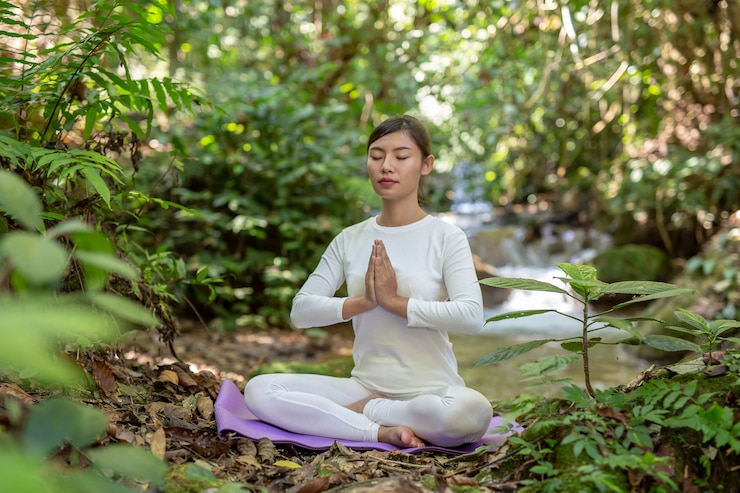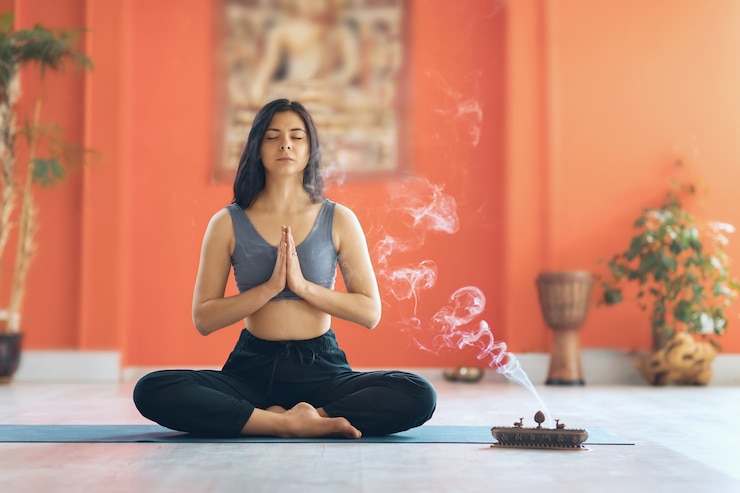Ask Ayurvedic doctor a question and get a consultation online on the problem of your concern in a free or paid mode. More than 2,000 experienced doctors work and wait for your questions on our site and help users to solve their health problems every day.
Shop Now in Our Store
Finding Your Dosha's Meditation Fit

Key Takeaways
- Understanding your dosha (Vata, Pitta, or Kapha) is essential for tailoring Meditation and Pranayama practices to your unique physical and mental state.
- Different Meditation techniques align with different doshas, enhancing your practice and overall wellbeing.
- Specific Pranayama breathing techniques in Ayurveda are designed to balance each dosha, promoting mental clarity.
- Crafting a personalized daily routine that incorporates Meditation and Pranayama practices tailored to your dosha can lead to optimal mental clarity and peace.
- Aligning your Meditation and Pranayama routines with your dosha offers long-term benefits, including improved mental clarity and overall wellness.
Ever wondered why some folks find peace in meditation while others thrive on dynamic breathing techniques? It could all boil down to your dosha. In Ayurveda, doshas are like the unique blueprints of your body and mind, shaping how you react to the world and which practices suit you best. We'll explore how to align meditation and pranayama with your dosha for a balanced life.
This article will guide you through understanding your dosha and how it influences your choice of meditation and pranayama techniques. With insights into breathing techniques Ayurveda style and tips for mental clarity, we'll help you find what fits you. Let's dive into the world of Ayurveda and discover the secrets it holds for your well-being.
Meditation Techniques to Consider
Finding the right meditation technique can be like choosing the perfect pair of shoes. It should fit comfortably with your lifestyle and personality. Let's break down a few popular methods you might explore.
-
Mindfulness Meditation: This practice encourages you to focus on the present moment. You pay attention to your thoughts and feelings without judgment. It's like watching a river flow by, but you don't jump in.
-
Guided Meditation: If you like structure, this might be your go-to. A guide, often through audio, leads you through a visual or mental journey. It’s like having a tour guide for your mind.
-
Transcendental Meditation (TM): Here, you repeat a specific mantra. This helps your mind settle into a state of deep rest. Think of it as a mental lullaby.
-
Zen Meditation (Zazen): This involves sitting in a specific posture and focusing on breathing. It’s about finding peace in stillness, like a mountain standing tall and calm.
-
Loving-kindness Meditation: Also known as Metta, it focuses on developing compassion and love for oneself and others. Imagine sending out waves of kindness like ripples in a pond.
Each technique offers unique benefits, and the best way to find your match is to try them out. Whether you're seeking mental clarity or a moment of peace, these practices offer a path to tranquility.
Pranayama for Every Dosha
Pranayama, a key part of Ayurveda, involves specific breathing techniques suited to different doshas: Vata, Pitta, and Kapha. Each dosha has unique characteristics, and pranayama can help balance them.
-
Vata Dosha: Vata types often experience anxiety or restlessness. Slow, deep breathing techniques, like Nadi Shodhana (alternate nostril breathing), can calm and ground them. This practice helps stabilize the fluctuating energy typical of Vata.
-
Pitta Dosha: Pitta types are prone to anger or impatience. Cooling breathing techniques, such as Sheetali (cooling breath), are beneficial. This technique involves curling the tongue and inhaling, bringing a sense of calm and reducing heat.
-
Kapha Dosha: Kapha types may feel lethargic or sluggish. Energizing techniques, like Kapalabhati (skull-shining breath), can invigorate and lift their spirits. This practice involves short, forceful exhales, promoting energy and clarity.
By understanding your dosha, you can choose the right pranayama practice. This enables a more balanced mind and body, enhancing mental clarity and overall well-being.

Crafting a Personalized Routine
Creating a personalized meditation and pranayama routine can make a world of difference. It’s like having a tailor-made suit that fits just right. According to a study by the National Center for Complementary and Integrative Health, 14.2% of adults in the U.S. have tried meditation at least once. This shows a growing interest in personalized wellness practices.
To start, identify your dosha. In Ayurveda, doshas are energies present in the body, and understanding them helps in choosing the right practices. For instance, if you’re a Vata type, grounding exercises like slow, deep breathing might suit you. Kapha types may benefit from more invigorating practices, while Pitta types might find balance with cooling, calming techniques.
Next, consider your lifestyle and schedule. If mornings are hectic, perhaps a short evening session works better. The key is consistency, even if it’s just five minutes a day. Meditation apps often provide guided sessions, making it easier to stick to a routine.
Finally, listen to your body and mind. Some days you might feel like a calming meditation, while other days a dynamic pranayama could be more beneficial. Flexibility is important, allowing your practice to evolve with your needs.

Benefits of Tailored Practices
Finding the right balance with Meditation and Pranayama, suited to your Dosha, can be a game-changer. Imagine harnessing the power of these practices to bring peace and harmony into your daily life. When you align your meditation and breathing techniques with your unique Dosha, you're not just practicing Ayurveda; you're creating a personalized wellness journey.
Tailored practices can lead to improved mental clarity, a key benefit of Ayurveda. The right meditation helps calm the mind while specific pranayama techniques boost your energy levels. This combination can lead to more focused thoughts and a calmer perspective on life's challenges. It's like having a personal toolkit for dealing with stress and anxiety.
Breathing techniques in Ayurveda are designed to suit different needs. Whether you need to relax or energize, there's something for everyone. By choosing practices that align with your Dosha, you ensure that your body and mind are working in harmony. This can lead to better health and a more balanced life.
Don't keep this journey to yourself. Share your experiences with friends or join an online community to discuss your progress. Engaging with others can offer new insights and deepen your understanding. Plus, it might inspire someone else to start their own journey toward balance and wellness.
Are you curious to learn more about how these practices can transform your life? Explore additional resources or connect with a local Ayurveda practitioner. Dive into the world of Meditation and Pranayama, and discover the benefits waiting for you. Your path to harmony and balance is just beginning.
FAQ For Dosha
What are the three doshas in Ayurveda, and how do they affect my meditation practice?
The three doshas in Ayurveda are Vata, Pitta, and Kapha. Each dosha represents different physical and mental characteristics. Understanding your dosha helps you tailor your meditation practice, ensuring it aligns with your unique constitution and enhances your mental clarity and relaxation.
How can I determine my dosha type?
You can determine your dosha type through self-assessment quizzes, consultations with an Ayurvedic practitioner, or by identifying dominant traits and imbalances in your body and mind. Knowing your dosha type helps you choose the right meditation and pranayama techniques.
Which meditation techniques are best suited for each dosha?
Vata types benefit from grounding practices like mindfulness and body scan meditation. Pitta types thrive with cooling techniques such as loving-kindness or nature-based meditation. Kapha types can enhance their practice with energizing styles like dynamic or mantra meditation.
What pranayama techniques are recommended for each dosha?
For Vata, calming pranayama like Nadi Shodhana (alternate nostril breathing) is beneficial. Pitta types should try Sheetali (cooling breath) to reduce heat. Kapha individuals benefit from invigorating techniques like Kapalabhati (skull shining breath) to boost energy and clarity.
How can I create a personalized daily routine for my dosha?
Start by incorporating meditation and pranayama practices that align with your dosha into your daily schedule. Consistency is key, so practice at the same time each day. Adjust the duration and intensity based on your needs to cultivate balance and mental clarity.
What are the benefits of aligning my meditation and pranayama practices with my dosha?
Tailoring your practices to your dosha can lead to improved mental clarity, emotional balance, and overall well-being. It helps in reducing stress, enhancing focus, and promoting a deeper connection between mind and body, leading to long-term health benefits.
Can my dosha change over time, and how should I adapt my practices if it does?
Yes, your dominant dosha can shift due to lifestyle changes, diet, and environment. Regularly reassess your dosha and adapt your meditation and pranayama techniques accordingly. This ensures your practices remain effective and supportive of your current state of balance.
This article is checked by the current qualified Dr Sujal Patil and can be considered a reliable source of information for users of the site.

